 |
Another boy
In 1928 Alan Turing was allowed to enter the sixth form of Sherborne School and to specialise in mathematics and science.
In the Science classes he met Christopher Morcom, another outstanding student and enthusiast for science.
Alan Turing began to communicate.
|
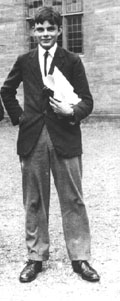 |
Alan Turing (left) and Christopher Morcom (below)
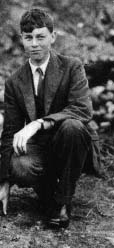 |
|
The picture shows them playing noughts and crosses in late 1929, and talking about mathematics and astronomy when they were meant to be doing French. |
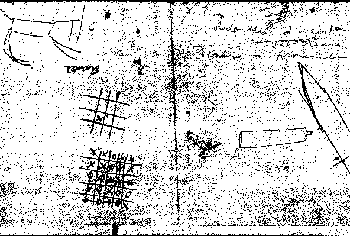 |
The figure on the right hand edge suggests that they were talking about the problem of the axiom of parallel lines in Euclidean geometry.
|
|
Alan Turing was in (unrequited) love.
In December 1929 they went to Cambridge together to sit the entrance examinations. Alan Turing described it...
| 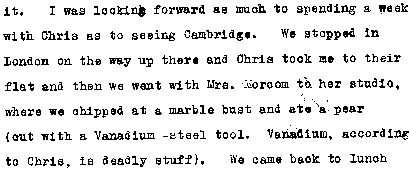 |
Christopher Morcom won a scholarship to Trinity College. Alan Turing didn't. Then —
|
|
Christopher Morcom suddenly died on 13 February 1930. |
| Somehow Alan Turing found the strength to come through the trauma. The next year, he won a scholarship to King's College, Cambridge.
| September 1931:
off the shore of Sark.
Surfing in thought. |
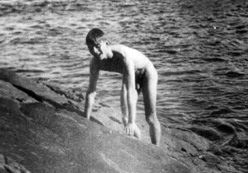 |
|
The Nature of Inspiration
From October 1931 Alan Turing was an undergraduate student at Cambridge, studying mathematics.
He was still deeply involved with the implications of Christopher Morcom's death. In 1932, on a visit to the Morcom family home, he wrote out a statement of belief in the survival of the spirit after death which brought in an appeal to the new science of quantum mechanics. It was headed "Nature of Spirit":
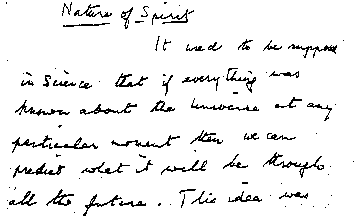
|
The whole essay is given in my book.
It suggested that the traditional picture of determinism in physical theory, and the apparent conflict with the sense of free will, had been overturned by the new quantum physics. He thought that quantum physics was directly involved in the brain, an idea suggested by Arthur S. Eddington in The Nature of the Physical World. |
Culture Clashes again
Typically, Alan Turing had been drawn to the central arena where scientific and religious thought come into conflict over the nature of the human mind and human will.
At the same time he had the conflict with society over his homosexuality, then completely illegal and almost unmentionable in public.
Alan Turing had good fortune in one way: King's College was notable for its private culture, fostered by liberal thinkers such as John Maynard Keynes, in which same-sex feelings were well understood.
| 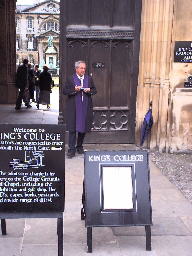 | The grand entrance to King's College on 24 June 2000, when King's held a day of events centred on Turing and Keynes.
King's College is the repository of Turing's papers, and in June 2012 held a further event to mark the centenary of his birth.
|
But Alan Turing never fitted well into any culture: he was no 'aesthete', but liked rowing and running. He was full of feeling which he shared with Christopher's mother, but not at the expense of his dedication to scientific explanation.
|
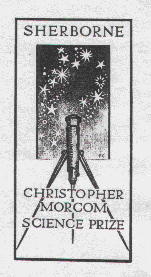 |
New physics, new brainwaves
Quantum mechanics was then really 'new physics', only formulated in 1926. But it is still in many ways a mystery.
The question of whether it has something to do with the nature of Mind has come to the foreground of serious enquiry again. The ideas of the mathematician Roger Penrose have been particularly close to the young Turing's speculations.
His theory is linked with the research of Stuart Hameroff on the possibility that the physiology of microtubules in the brain depends crucially on quantum-mechanical effects.
Roger Penrose has an on-line paper
Beyond the Doubting of a Shadow, responding to criticism and adding further ideas about the physics of the brain.
|
Another Inspiration
In 1932, it was reading von Neumann's new book on the
Mathematical Foundations of Quantum Mechanics
that first brought Alan Turing to the edge of new work in mathematics.
Then in 1933 he read about mathematical logic in the work of Bertrand Russell.
Bringing mathematical logic to bear on the problem of mind and matter turned out to be Alan Turing's crucial innovation.
In 1935 he was elected to a Fellowship of the college, and in the same year had his greatest inspiration: the idea of the Turing Machine ....
| 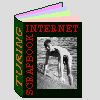
Continue to the next Scrapbook page.
|
|
|